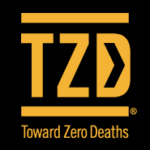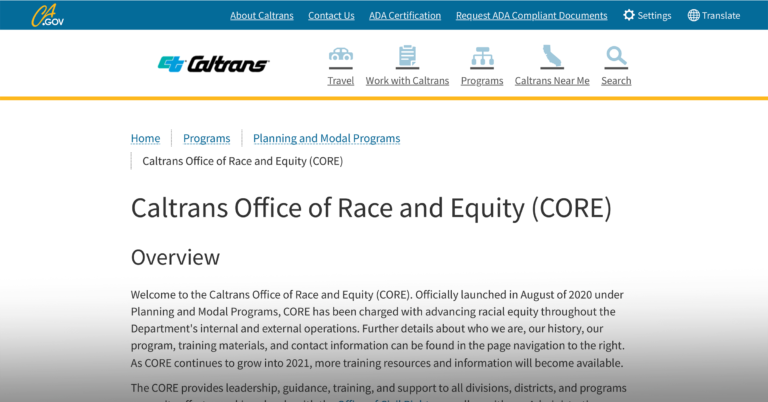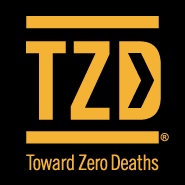The California Department of Transportation (Caltrans) began developing their groundwork for safety and equity to come together. Over the past two years, Caltrans has made strides forward in this goal, starting with establishing a new Division of Safety Programs to build California’s Strategic Highway Safety Plan (SHSP) on four safety-focused principles:
- Double Down on What Works
- Accelerate Advanced Technology
- Implement Safe System Approach
- Integrate Equity
In 2016, Caltrans began to look at locations in California with the highest concentration of crashes for the Department’s first-ever systemic safety program for pedestrians. Focusing on these areas was an important step and in 2019 this view of locations expanded to consider a more proactive approach: addressing risks before crashes happened. Using a data driven approach, they identified areas with specific risk factors throughout the state highway system and prioritized these areas for improvements using the following criteria:
- crash data
- roadway features
- crash types
- equity metrics
Developing an equity index, equity statement, and an SHSP Equity-Related Working Group
Caltrans used the metrics created for the CalEnviroScreen, an equity index mapping tool originally created by the California Office of Environmental Health Hazard Assessment (OEHHA). This tool uses information from the U.S. Census, federal and state sources and to quantify the burden of air pollution on California communities. The equity metrics were developed from measurements of disadvantaged communities, senior population density, youth population density and proximity to schools.
Using these four criteria, all locations were scored and then reported to Caltrans districts as those that could potentially receive improvements. This created an actionable system to make recommendations that had a foundation of equity.
In 2021, the Caltrans SHSP Steering Committee added a working definition of equity in the revised California SHSP. This working definition was collaboratively developed and unanimously approved by the SHSP Steering Committee.
To create a truly valuable equity statement, Caltrans expanded the variety of external partners, participants, and ultimately decision makers in the Steering and Executive Committees. The Committees added advocacy groups, like Vision Zero Network, and made the decision to pull from local government agencies, rather than only including state departments. These efforts were coordinated closely with the Caltrans Office of Race and Equity (CORE).
Out of these diverse Committees, Caltrans was able to produce a new working definition of equity that all the partners will share. To further support the adoption of the equity statement, factsheets were made using race-based, socioeconomic, and demographic data to help organizations understand where the application of transportation equity was still a challenge. Equity will remain one of the four guiding principles of the Caltrans SHSP. This ensures, along with ongoing coordination with CORE, that those individuals guiding its development will continue to align the strategies outlined in the SHSP with equity concepts. The plan is primed to evolve as new data becomes available.
Caltrans also launched the SHSP Equity-Related Working Group work group for the SHSP in July 2021. The work group will review equity-related data, and the successes and lessons learned from equity-related actions in the SHSP. Beginning in March 2022, a CORE representative will also participate in this working group.
Progress in equity efforts and next steps
Caltrans has been pleased to see the progress made by using the CalEnviroScreen index as part of the scoring criteria, as they were able to identify 500 locations for traffic safety improvements which will be further investigated by district staff. This prompted Caltrans to create its own equity index based on transportation burden, instead of only air quality. The transportation burden index will include income levels, air pollution, and transportation burden to weight the equity scoring more accurately of future safety improvements.
One of the tasks of CORE is to build this new equity index. CORE’s goals center around making equity-related decisions, which will support safety efforts when both crash investigations and safety improvement projects are discussed. Together with the Safety Programs Office, the SHSP team is working with California State Universities, to develop the working definition of equity in safety—approved by the SHSP Steering Committee. This working definition will help the Safety Programs Office develop its own equity objectives and goals.
In addition to academic support, and as part of their mission to define equity, the CORE Director, Amar Cid, completed what she called “road shows” throughout the district offices to learn how staff apply equity in their districts. Amar included in each road show the important question: “What is equity and what does it mean in your job”? Much has been learned from staff insights into how individuals and districts translate high level policy statements into day-to-day implementation of equity. With a similar focus to learn from local efforts, the California SHSP Equity-Related Working Group and Safety Programs will also participate in several upcoming community/regional sessions planned in late 2022.
Once an updated definition of equity is defined, CORE will proceed with building an equity index of 26 indicators of equity, with safety being a key indicator. This new index will serve as an important piece in further evolving the foundation of equity into the California SHSP and adding in the most effective strategies, data and indexes for equity.
The California SHSP team plans to update the document with new data and insights as they become available. With the help of local and regional agencies, Caltrans will identity existing public outreach forums to both provide information to and solicit feedback from community leaders. They will weigh in on the implementation of the current SHSP and how effective it has been as it grows. As more equity-related actions are identified, the newly created Office of Safety Programs will manage and monitor the implementation of these actions and align with CORE and advocate for continued progress in traffic safety equity now and in the future.
Contact
For more information about Caltrans’ equity in traffic safety efforts, contact Cindy Utter, Caltrans SHSP Coordinator, cindy.utter@dot.ca.gov, or Nagi Pagadala, chief of the Caltrans Office of Strategic Safety & Implementation, nagi.pagadala@dot.ca.gov.


